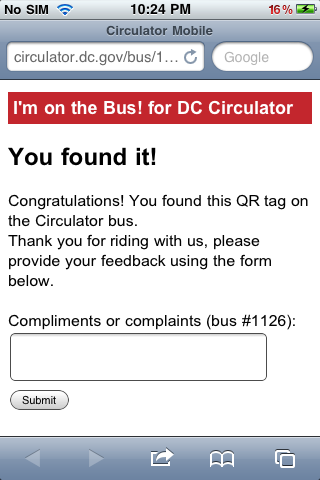Rider feedback for transit systems: the good and the bad
In July 2010, I attended a briefing for developers put on by WMATA, in advance of the launch of WMATA's open data initiatives. One of the points expressed by developers at the meeting was a desire to give riders an easy way to provide feedback to WMATA from within mobile transit apps. So, while I was browsing the MBTA's developer resources page recently, I was interested to see that they have a pilot program to allow developers to communicate rider feedback to the MBTA from within apps. The program, called Commuter Connect, offers a web service which accepts text and images from riders. It looked great to me, until I checked the documentation. Rather than offering riders a simple free-form comment field, riders must give their full name, email address, home city, state, and ZIP code (what about non-US residents?), among other fields. Worse, riders must select a 'topic' and 'subtopic', choosing from dozens of cryptically-named options, like "Insensitive to Cust Needs" and "Passenger Bypass".
The FAQ for the program says:
Why so many required fields? Commuter Connect is built as a part of customer care center′s management system. For us to follow-up on comments, we need all required fields. For full details of how to use the system please closely review the documentation.
Simply put, the problem with Commuter Connect is that it communicates with riders in the vernacular of the transit system, and expects them to do the same. There's no absolute reason that riders have to classify the problem they're submitting (least of all in the transit agency's specialized vernacular); that can be done by the transit agency's staff. More to the point, it exemplifies the sort of tone-deafness which perpetuates communication with riders by mass transit agencies—an inability to use plain language and communicate clearly. WMATA's customer comment form exhibits the same problem—essentially ignoring rider feedback if the rider cannot be bothered to jump through all of the transit agency's hoops—along with an expectation that riders will describe their problems in the same terms the transit agency would use. Perhaps the only redeeming factor for the MBTA's Commuter Connect program is that it makes it easy to upload a photo (but accepting video as well would be even better).
By contrast, the approach taken by DDOT with the DC Circulator is a model for making rider feedback easy. Every Circulator bus has stickers prominently applied with a QR code and URL which allow riders to provide feedback; the feedback form is simple and uncomplicated:

The mobile site requires no specialized software, and works on any device with a Web browser. Riders are not required to provide their personal information, nor are they required to categorize their comment according to the narrow confines of the transit agency's schema. At the same time, if a rider wants to provide their contact information, there's nothing stopping them from including it with their remarks. DDOT's approach is designed to accept as much feedback as possible, rather than rejecting potential valuable feedback based on technicalities (like failure to include one's home ZIP code, or classify one's comment into arcane categories).
In short, transit agencies should be responsive to rider feedback even though it may come in a range of forms, and they should make the process as straightforward as possible—more like the DC Circulator, less like WMATA and the MBTA.